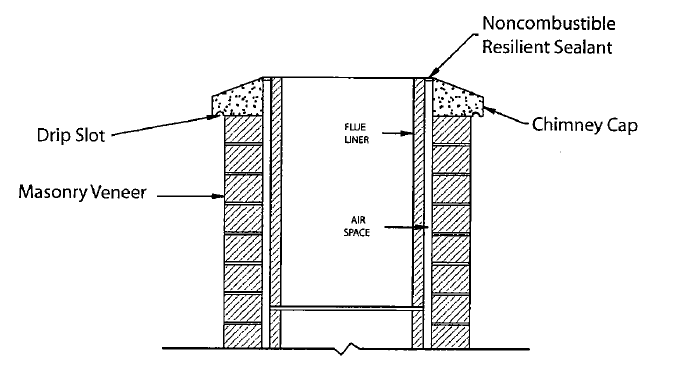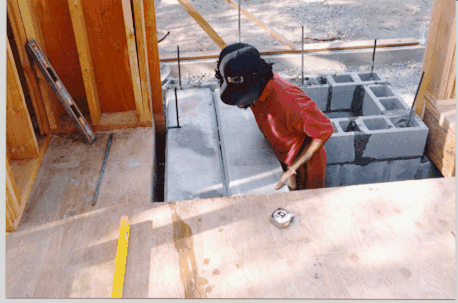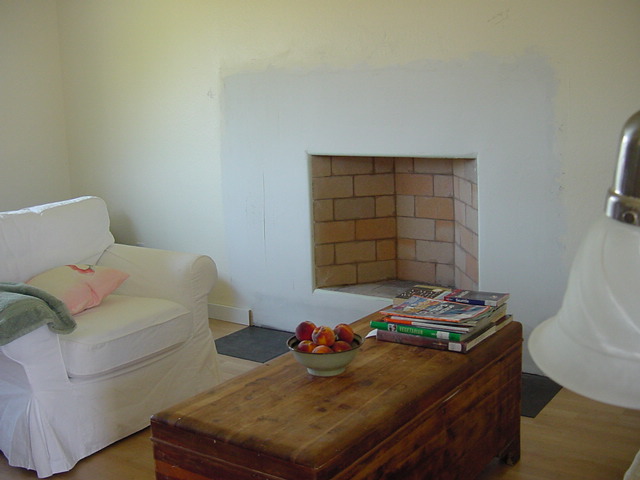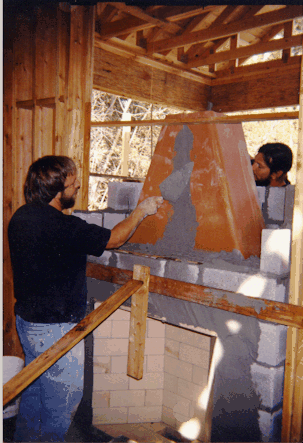Code Issues
7/17/17
|
|
|
|
Fireplace Clearance |
|
|
Code R1001.11 Fireplace clearance. All wood beams, joists, studs and other combustible material shall have a clearance of not less than 2 inches (51 mm) from the front faces and sides of masonry fireplaces and not less than 4 inches (102 mm) from the back faces of masonry fireplaces. The air space shall not be filled, except to provide fire blocking in accordance with Section R1001.12. Exceptions: 1. Masonry fireplaces listed and labeled for use in contact with combustibles in accordance with UL 127 and installed in accordance with the manufacturers installation instructions are permitted to have combustible material in contact with their exterior surfaces. 2. When masonry fireplaces are part of masonry or concrete walls, combustible materials shall not be in contact with the masonry or concrete walls less than 12 inches (305 mm)from the inside surface of the nearest firebox lining. 3. Exposed combustible trim and the edges of sheathing materials such as wood siding, flooring and drywall shall be permitted to abut the masonry fireplace side walls and hearth extension in accordance with Figure R1001.11, provided such combustible trim or sheathing is a minimum of 12 inches (305 mm) from the inside surface of the nearest firebox lining. 4. Exposed combustible mantels or trim may be placed directly on the masonry fireplace front surrounding the fireplace opening providing such combustible materials are not placed within 6 inches (152 mm) of a fireplace opening. Combustible material within 12 inches (306 mm) of the fireplace opening shall not project more than 1/8 inch (3 mm) for each 1-inch (25 mm) distance from such an opening.
|
Commentary Current code on clearance to combustible materials from masonry fireplaces is basically one unbuildable paragraph with four exceptions. It is noteworthy that the clearance at the back of the firebox was increased from 2" to 4" based on evidence that the "hot spot" is right behind the fireplace. We too are conservative here and show all our Rumfords to have 12" thick firebox walls even though 8" thick meets code. Exception 1 allows a proprietary tested and listed fireplace to be installed according to the listing. Exception 2 permits masonry fireplaces which are part of masonry walls to be in contact with combustibles provided the combustible are at least 12" from an interior flue lining. This language allows thickness and mass to compensate for clearance. Exception 3 allows combustible trim, flooring and siding to touch the masonry repeating the 12" distance from an interior lining surface rule and reinforcing the principle of thickness and mass as a substitute for air space. This is consistent with historical fire safety practices and recent testing. Exception 4 allows mantels and trim on the front of a fireplace to be as close as 6" to the fireplace opening as was permitted in previous codes. In summary, the code could be more succinctly and directly written instead of being a list of exceptions to an unbuildable general rule. The idea that mass and thickness may compensate for clearance is important, however. Another principle is also important but is not stated. It's the idea that combustibles that are exposed such as trim, siding, mantles and flooring, are not as dangerous or insidious as combustibles like the framing you can't see. The idea that the chimney could be bare (at least not totally enclosed with framing) and that trim could touch it here and there would be safer is implied if not stated. It's also the way houses used to be built.
|
|
Chimney Clearances |
|
|
Code R1003.18 Chimney clearances. Any portion of a masonry chimney located in the interior of the building or within the exterior wall of the building shall have a minimum air space clearance to combustibles of 2 inches (51 mm). Chimneys located entirely outside the exterior walls of the building, including chimneys that pass through the soffit or cornice, shall have a minimum air space clearance of 1 inch (25 mm). The air space shall not be filled, except to provide fire blocking in accordance with Section R1003.19. Exceptions: 1. Masonry chimneys equipped with a chimney lining system listed and labeled for use in chimneys in contact with combustibles in accordance with UL 1777 and installed in accordance with the manufacturers installation instructions are permitted to have combustible material in contact with their exterior surfaces. 2. When masonry chimneys are constructed as part of masonry or concrete walls, combustible materials shall not be in contact with the masonry or concrete wall less than 12 inches (305 mm) from the inside surface of the nearest flue lining. 3. Exposed combustible trim and the edges of sheathing materials, such as wood siding and flooring, shall be permitted to abut the masonry chimney side walls, in accordance with Figure R1003.18, provided such combustible trim or sheathing is a minimum of 12 inches (305 mm) from the inside surface of the nearest flue lining. Combustible material and trim shall not overlap the corners of the chimney by more than 1 inch (25 mm).
|
Commentary Current code on clearance to combustible materials from masonry chimneys favors enclosing the entire masonry chimney within a frame chase. The code makes it difficult to build chimneys with exposed masonry walls or with plaster and trim like baseboards and flooring directly in contact with the masonry, as was common historically. But there is hope. As with the firebox clearance language, there are three exceptions that recognize for the first time in recent years that thickness, mass and heat dissipation may be legitimate substitutes for clearance as fire prevention strategies. Exception 1 is an obvious exception for any tested, listed and labeled system. Exception 2 permits masonry chimneys which are part of masonry walls to be in contact with combustibles provided the combustible are at least 12" from an interior flue lining. This is a relatively new code provision and is interesting because it shows how far we have slid since houses were built of brick. Without this exception masonry chimneys could not be built within masonry walls if those walls were anywhere in contact with combustibles. This exception provides something of a solution in that for the first time in many years, it allows thickness and mass to compensate for clearance. Exception 3 is a litany of other specific situations in which combustible trim, flooring and siding may touch the masonry. Again the 12" rule is mentioned and is precedent-setting in establishing the principle of thickness and mass as a substitute for air space. In 2013 we changed the code to allow 8" of solid masonry as an adequate alternative to 4" of masonry plus 2" of air space based on the experience of historic fire prevention strategies and our testing. |
|
Code R1003.5 Firebox walls. Masonry fireboxes shall be constructed of solid masonry units, hollow masonry units grouted solid, stone or concrete. When a lining of firebrick at least 2 inches (51 mm) in thickness or other approved lining is provided, the minimum thickness of back and side walls shall each be 8 inches (203 mm) of solid masonry, including the lining. The width of joints between firebricks shall not be greater than 1/4 inch (6.4 mm). When no lining is provided, the total minimum thickness of back and side walls shall be 10 inches (254 mm) of solid masonry. Firebrick shall conform to ASTM C 27 or C 1261 and shall be laid with medium-duty refractory mortar conforming to ASTM C 199. |
Commentary Firebrick, if used, must meet ASTM C 27 or C 1261 and refractory mortar must comply with to ASTM C 199. Note, however, that firebrick (and presumably refractory mortar) are not required. The language is "When a lining of firebrick ... is provided..." That means you can use red brick or stone to line a firebox. The firebox walls just have to be 10" thick instead of 8" thick. So, is it a good idea? Firebrick and refractory mortar are refractory products that can stand the high temperature and thermal shock they are subjected to in a firebox. Some stone, like soapstone, perform well but most face brick and most natural stone will crack or spall due to thermal shock in a firebox. Ordinary Portland cement mortar will not withstand the high temperatures either. After several cycles through 600 degrees F the Portland cement will disintegrate. So the code specifies refractory mortar conforming to ASTM C 199 - not "fireclay mortar" which is often nothing more that ordinary Portland cement mortar with some fireclay added.
|
|
Code R1003.9 Hearth and hearth extension. Masonry fireplace hearths and hearth extensions shall be constructed of concrete or masonry, supported by noncombustible materials, and reinforced to carry their own weight and all imposed loads. No combustible material shall remain against the underside of hearths and hearth extensions after construction. R1003.9.1 Hearth thickness. The minimum thickness of fireplace hearths shall be 4 inches (102 mm). R1003.9.2 Hearth extension thickness. The minimum thickness of hearth extensions shall be 2 inches (51 mm). Exception: When the bottom of the firebox opening is raised at least 8 inches (203 mm) above the top of the hearth extension, a hearth extension of not less than 3/8 -inch-thick (9.5 mm) brick, concrete, stone, tile or other approved noncombustible material is permitted. |
Commentary The only thing new here is to allow 2" thick hearth extensions and to allow for a 3/8" noncombustible material laid on a combustible floor if the inner hearth is at least 8" above the floor. |
|
Code R1001.8 Smoke chamber. Smoke chamber walls shall be constructed of solid masonry units, hollow masonry units grouted solid, stone or concrete. Corbeling of masonry units shall not leave unit cores exposed to the inside of the smoke chamber. When a lining of firebrick at least 2 inches (51 mm) thick, or a lining of vitrified clay at least 5/8 inch (16 mm) thick, is provided, the total minimum thickness of front, back and side walls shall be 6 inches (152 mm) of solid masonry, including the lining. Firebrick shall conform to ASTM C 27 or C 1261 and shall be laid with medium duty refractory mortar conforming to ASTM C199. Where no lining is provided, the total minimum thickness of front, back and side walls shall be 8 inches (203 mm) of solid masonry. When the inside surface of the smoke chamber is formed by corbeled masonry, the inside surface shall be parged smooth. R1001.8.1 Smoke chamber dimensions. The inside height of the smoke chamber from the fireplace throat to the beginning of the flue shall not be greater than the inside width of the fireplace opening. The inside surface of the smoke chamber shall not be inclined more than 45 degrees (0.79 rad) from vertical when prefabricated smoke chamber linings are used or when the smoke chamber walls are rolled or sloped rather than corbeled. When the inside surface of the smoke chamber is formed by corbeled masonry, the walls shall not be corbeled more than 30 degrees (0.52 rad) from vertical. |
Commentary Smoke chamber walls can be reduced to one 4" wythe of masonry enclosing a manufactured clay or metal smoke chamber liner so the total smoke chamber wall thickness is at leas 6". Smoke chamber walls may also slope up to 45 degrees from vertical.
|
|
Code R1003.12 Clay flue lining (installation). Clay flue liners shall be installed in accordance with ASTM C 1283 and extend from a point not less than 8 inches (203 mm) below the lowest inlet or, in the case of fireplaces, from the top of the smoke chamber to a point above the enclosing walls. The lining shall be carried up vertically, with a maximum slope no greater than 30 degrees (0.52 rad) from the vertical. Clay flue liners shall be laid in medium-duty refractory mortar conforming to ASTM C 199 with tight mortar joints left smooth on the inside and installed to maintain an air space or insulation not to exceed the thickness of the flue liner separating the flue liners from the interior face of the chimney masonry walls. Flue liners shall be supported on all sides. Only enough mortar shall be placed to make the joint and hold the liners in position. R1003.3 Seismic reinforcing. Masonry or concrete chimneys in Seismic Design Categories D1 and D2 shall be reinforced. Reinforcing shall conform to the requirements set forth in Table R1003.1 and Section R609, Grouted Masonry. R1003.3.1 Vertical reinforcing. For chimneys up to 40 inches (1016 mm) wide, four No. 4 continuous vertical bars shall be placed between wythes of solid masonry or within the cells of hollow unit masonry and grouted in accordance with Section R609. Grout shall be prevented from bonding with the flue liner so that the flue liner is free to move with thermal expansion. For chimneys greater than 40 inches (1016 mm) wide, two additional No. 4 vertical bars shall be provided for each additional flue incorporated in the chimney or for each additional 40 inches (1016 mm) in width or fraction thereof. R1003.3.2 Horizontal reinforcing. Vertical reinforcement shall be placed within 1 /4 -inch (6.4 mm) ties, or other reinforcing of equivalent net cross-sectional area, placed in the bed joints according to Section R607 at a minimum of every 18 inches (457 mm) of vertical height. Two such ties shall be provided at each bend in the vertical bars.
|
Commentary The new code language is pretty clear. Here are the highlights:

Comments about joint reinforcing by John Bufford and John Swink. |


Back to Codes Training
Buckley Rumford Fireplaces
Copyright 1995 - 2017 Jim Buckley
All rights reserved.





